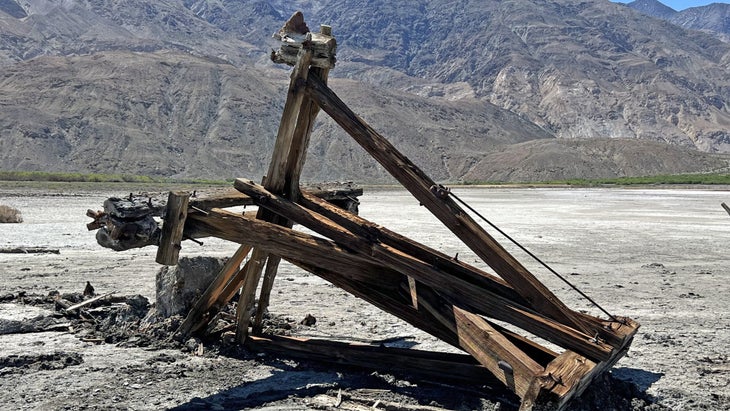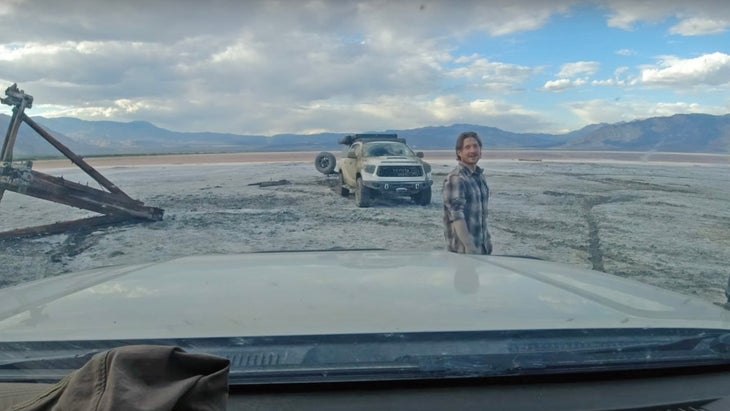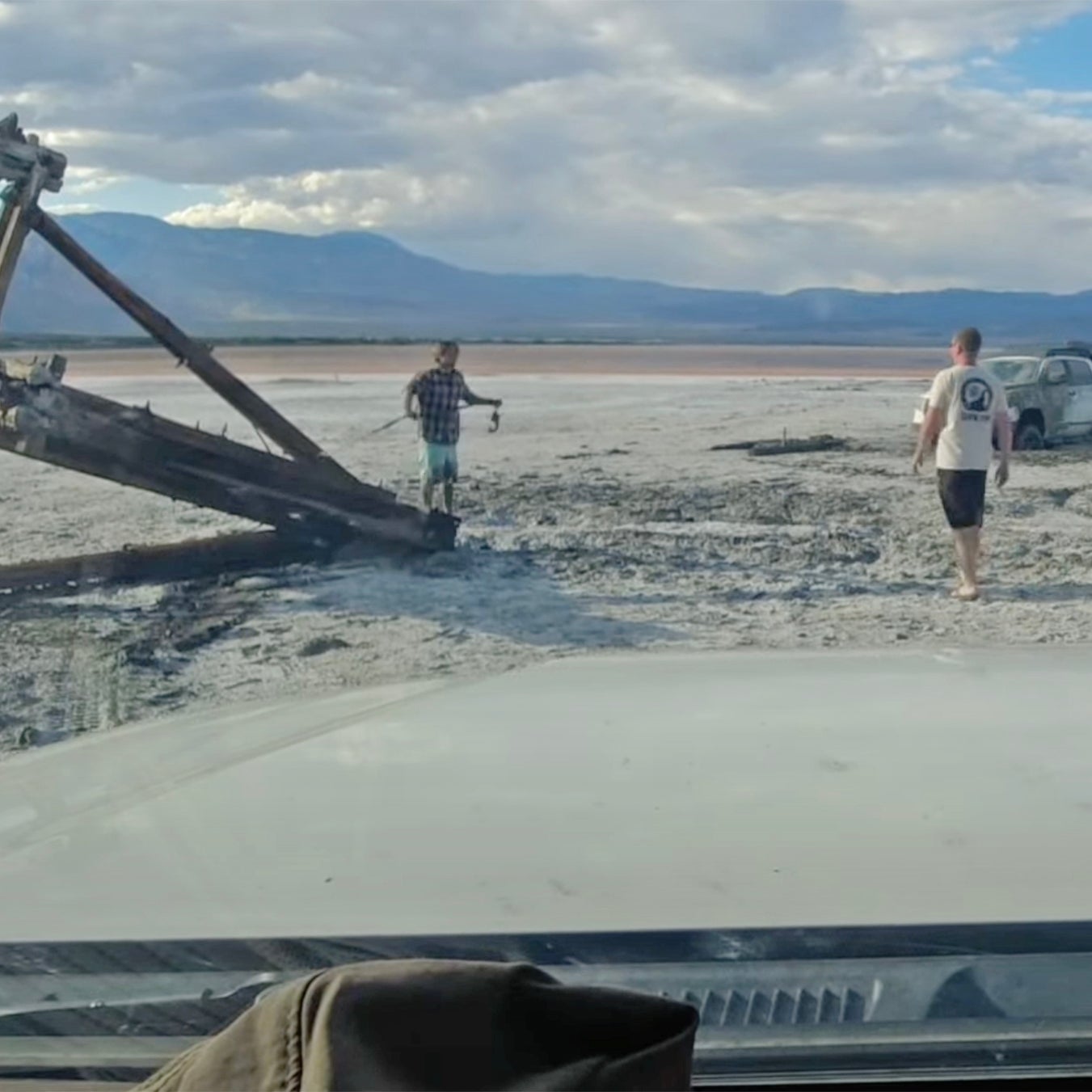On May 13, the National Park Service issued a press release disclosing that a historic 113-year-old salt tram tower in Death Valley National Park had been pulled down by an irresponsible driver. Now, there’s video that may show the incident’s aftermath.
“The National Park Service (NPS) seeks information about recent damage to a historic salt tram tower in Saline Valley,” reads the release. “It appears the 113-year-old tower was pulled over while a person used a winch to extract their vehicle out of deep mud. The damage happened sometime between April 1 and April 24, 2024.”
A video uploaded to YouTube on April 27—shortly after the incident took place—appears to show the immediate aftermath of the event, and may identify the alleged perpetrators. That video was taken down on May 15, but Outside reviewed it in the days prior.
The National Park Service confirmed that they have seen and downloaded the video.
“While we don’t comment on ongoing investigations, the response to this incident from the off-road community has been humbling,” an NPS spokesperson told Outside. “We’ve received an overwhelming amount of information attempting to help identify the individuals responsible and help repair the damage. We will notify people of potential volunteer opportunities at the appropriate time.”
The video appears to have been recorded on a dash cam. At the two-and-a-half minute mark of the original 11-minute video, the the driver is narrating his encounter with a person wearing “daisy dukes and a halter top.”

The location of the tram tower is about 40 miles into Saline Valley Road—a rough 4×4 route—far from the nearest pavement at Highway 190. It’s an area I’ve traveled through many times, and am very familiar with.
The historic tram towers were constructed in 1911 to ferry salt from the remote Saline Valley, over the rugged Inyo Mountains, and into Owens Valley, 13 miles away, in a straight line.
“The tramway climbed over 7,000 vertical feet at steep grades up to 40 degrees,” stated an NPS official in a release. “Saline Valley Salt Tram is listed on the National Register of Historic Places. It is considered nationally significant because of its age, length, steepness, preservation, and scenic setting.”
“Tram tower #1 is the tower closest to Saline Valley lakebed,” the release continued. “Nearby tracks show that a vehicle drove a short distance off the legal roadway and got stuck in mud. Park rangers believe that someone used the nearby tower as an anchor to pull their vehicle out of the mud. The tower toppled over, pulling its concrete footings out of the ground.”

“We need a winch,” the woman tells the filming driver at the original 2:35 time stamp. “We went a little too far into the mud, and there’s nothing to press the winch onto. See that last tower? Honestly, you guys can get into maybe like 20 feet easily, we just need something to latch onto, we’ve got nothing.”
The driver then pulls down the access road that runs along the old tram line, and pulls into the turn around at the end of the road. The delineation between terrain that can safely be driven and impossibly deep mud is, in my experience, very clear at that point. But visible is a truck stuck up to its axles, about 20 feet beyond that point.

At this point in the video, the tram tower is already toppled. We have no way of knowing if this is the vehicle or the drivers who pulled it down. But, at 3:45 in the original video, we can see someone disconnect the truck’s winch cable from the damaged tower, and drag it back to the truck.
A close up shortly after shows the vehicle in detail. It’s a white Toyota Tundra, of the generation made between 2006 and 2021. It appears to be extensively modified with a Topo Toppers Mesa camper, a roof rack, a high clearance front bumper, and a winch.
The driver of the dash cam-equipped vehicle then goes onto attempt a straight winch pull. Vehicles stuck in deep mud can create resistance equivalent to two to three-times the weight of the vehicle itself, and that Tundra’s gross vehicle weight rating is 7,200 pounds. So it’s no surprise that attempt fails. Most winches on mid-size 4x4s are rated for a capacity of 12,000 pounds, or less.

At 5:30 in the original video, we can see the drivers attempt to attach a second winch line from another vehicle. The drivers then reposition the winch lines to separate recovery points, and attach a third line, which eventually frees the stuck Tundra. At no point are pulleys or dampers involved, which could have respectively reduced forces, and reduced the risk created by a broken line, shackle, or attachment point. The forces here must have been huge—at least 20,000 pounds—so any equipment failure would have resulted in potentially deadly consequences.
At 10:10 in the source video, the truck is eventually pulled to dry ground. Judging by the amount of phones seen in the video, this is likely not the only video or photos of the incident.
“The NPS already had a salt tram stabilization project planned before this damage happened, funded by the Inflation Reduction Act,” concluded the NPS. “The project manager has not determined if that funding can be used to re-anchor tower #1.”
“Park rangers ask that anyone with information on this incident contact the NPS-wide tip line at 888-653-0009 or go.nps.gov/SubmitATip.”
“I hope the person responsible for this damage will contact us so we can discuss restitution,” says Death Valley National Park Superintendent Mike Reynolds.

